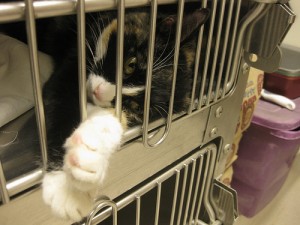Good Reasons to Keep Your Cat Indoors
May 29, 2009 by LaBecs
Filed under Good Reasons to Keep Your Cat Indoors
For many cat owners, the choice of whether to keep their cat indoors or to let it roam free at least part of the time is difficult. Some cat lovers believe keeping your cat cooped up indoors all of the time amounts to cruelty. Other cat lovers argue that the dangers of allowing domesticated cats to run in the streets far outweighs any potential benefits for the cat. From the title of this piece, you can probably guess which side of the issue I’m going to side with. But I think it’s important for people to realize how dangerous things can be for cats on the streets.
The Disease Factor
Cats that spend even part of the time outside are at a significantly higher risk of catching one of the common feline diseases than those who live indoors. And don’t assume your cat is not at risk because he or she has been vaccinated. According to the Community Animal Welfare Society, most vaccines only provide up to 85% protection against these diseases so your cat is still a risk of becoming gravely ill.
Feline Leukemia is one of the most common diseases in cats and is transmitted through cat saliva, which means a stray cat that licks your roaming pet or a water source used by multiple cats can be a source of the disease. A second serious disease is Feline Immunodeficiency Virus (FIV). This disease is transmitted through cat blood so if your pet becomes involved in a fight with another cat while roaming outdoors he could contract the disease. Unfortunately, FIV is fatal and no cure is available at this time.
The Human Element
While cats do run a serious risk of catching disease from other felines outdoors, that’s not the only risk they face. Not everyone in your community is going to appreciate the activity of these free-roaming cats. A neighbor fed up with the cat’s visits to their yard, might deliberately leave out poisoned cat food or other dangerous things for cats. In other cases, toxic chemicals, such as those in antifreeze, are located in places where cats like to end up and can result in their death.
Humans can also be cruel. Around Halloween every year, hundreds of black cats are killed around the country in pranks. Cats that roam the streets are a very likely target for this type of behavior, especially since most owners let them out for the night when pranksters are most often on the prowl. They can also be caught and sold to research facilities, or taken to a shelter, where they will be euthanized in as little as 2 days if you don’t know he is lost.
Other Risks
Besides disease and human cruelty, roaming cats have other reasons to be afraid. They are an easy victim for dogs and other predators, and traffic. Who knows how many pets can be found flattened on the pavement every night. Cats can also be killed by cars in other ways since they like to sleep under them.

Build a Nice Outside Area
Cats that run in the neighborhood are also much more likely to contribute to the out-of-control cat population. Unless you have spayed or neutered your free roaming feline, you are undoubtedly adding to the problem. Too many cats are already euthanized daily because they do not have a proper home.
In some cases, very cruel owners will have their cats de-clawed but still allow them to roam the streets at night. This leaves the cat defenseless in the face of an attack. Not only can the cat not fight back against predators or other cats, but he or she cannot even scale a tree or a fence for protection from the attackers or from other threats.
The bottom line is that letting your cat outside provides no real benefits – only very real risks – to your cat’s health and safety. Don’t do it.
If you feel your cat is missing out, provide him with a good cat condo, if you lack the space you can always buy cheap Ikea shelves, glue on pieces of carpet that you can get as scrap at carpet places, and put them on the wall so your cat can climb up on the wall. They even look cool!
Give him or her a nice window seat to look out.
Teach them to walk on a leash. Yes they can be trained. They will initially feel confined by the harness, and their first attempts at walking on a leash might look uncomfortable and a waste of time, but with love and patience on your part, most cats will enjoy leash walking.
Build them an outdoor condo where they can come out and enjoy the sunshine if you have the space. You don’t have to spend a fortune.
Get them a mesh front carrier. Most are for dogs, but they can be used for cats as well. You can take them with you and go for walks, or get them a kitty stroller. You can get them at good prices online.
The point is, you can keep them safe and satisfied, and exercised, and they will never miss the great outdoors.
Bringing a Kitten Home
May 10, 2009 by LaBecs
Filed under Preparing For a New Kitten
Chances are your entire family is going to be excited about bringing a kitten home. Or maybe your are bringing a grown cat to your family. But you’ve got to remember your new feline addition doesn’t know to be excited. He or she just knows to be nervous. That’s why you want to make the transition as calm and smooth for your new pet as possible. For starters, try to remain calm when bringing a kitten home. If you have children, discourage them from chasing, holding, or trying to give the cat a lot of affection for the first few days. Let the cat get settled first.
You should also remember that cats are extremely curious. Because cats should be kept indoors for their health and safety, you want to make sure there are no escape routes to the outdoors your cat might find while snooping around its new environment. Keep in mind that cats can make themselves pretty small if necessary to sneak out so don’t take any chances. Posting notes on all of the doors to remind family members and guests to watch out for a potentially escaping kitten is also a smart idea.
Because your cat is going to need to feel comfortable riding in the car when you take him or her home, invest in a pet carrier and add some blankets, toys, or anything that smells like the cat’s previous living quarters. This is going to make her more comfortable. Always have your cat in the carrier while traveling by car. She will feel safer than if you let her roam freely around the car. Plus, a curious cat could cause you to have an accident.
For the first few days, you’ve got to resist that urge to cuddle and love your new kitten. She needs to feel safe and comfortable before you overwhelm her with your affection. And cats tend to be a lot more cautious than dogs.

Matilda
When you first arrive home, take the carrier to a room in your home. It’s a good idea to use your own bedroom so the cat can become comfortable with the adults in the home first. Plus, children have a hard time resisting the impulse to hug the kitten. Inside the room, place the carrier on the floor and open the door. Have the cat’s food, water, and litter box inside the room as well. You want to confine the cat to this small space before opening up the entire house to her. Remember not to pressure or coax her to come out. When she feels comfortable, she will emerge from the carrier and begin a thorough investigation of the area.
Try to minimize the cat’s contact with your children or other pets for a few days. Then you can begin slowly introducing them. Make sure that your kids stay calm around the cat and talk in a quiet voice as to not startle her. As far as the introduction to the other animals, this should be done slowly and always in a very controlled way. You want to make sure they are going to get along well before you allow them to have complete access to one another.
When you are expanding your kitten’s access to the rest of the house, make sure to carefully kitten-proof it. That means eliminate anything that might look like a toy, including window blind cords and electrical wires. If there are any places you do not want your cat to go, spray them with a lemon-scented liquid. Give your kitten some safe toys to keep her occupied and out of trouble.
Now, you are ready to fully enjoy bringing a kitten home and having it as a new family member.
Top Ten Friendliest Cats
April 24, 2009 by LaBecs
Filed under Friendliest Cats
I think all cat owners have made this mistake: they go to the shelter or rescue and choose the cutest cat in the bunch, without even considering its temperament or personality. Then it turns out the cat ends up not being what they expected. Some are timid, some like to be petted and others don’t, others love to play, while others will hide under the bed all day. What are the friendliest cats? When you go to the shelter or rescue, always ask the people in charge what breeds the cats they have there resemble the most. They will almost always tell you, “This one has a little Ragdoll in it, this other has a bit of Maine Coon”, and many times you will find pure breeds that have been abandoned… so keep this list of the top ten friendliest cat breeds before you go to find the most wonderful treasure you will ever have.
Click on each picture to see their wonderful qualities:
(See below for a list of picture credits)
 #10 Chantilly-Tiffany |
 #9 Somali |
 #8 Ragdoll |
 #7 Persian |
 #6 Manx |
 #5 Maine Coon |

#4
Burmese |
 #3 Birman |
 #2 Exotic Short Hair |
 #1 Abyssinian |
CLICK HERE TO SEE THE FRIENDLIEST DOGS…
Photo Credits:
Persian Cat
Are You Really Ready to Adopt a Pet?
March 24, 2009 by LaBecs
Filed under Are You Really Ready to Adopt a Pet?
It always happens. Every time you see the picture of a cute little pup or furry little kitten, you ‘awww’ and ‘oooh’ and you just want one! You can’t help but pet each dog that comes your way while walking on the street and you bring tasty treats for your friend’s pets when you go visiting.
Every time a pup licks you or a cat rubs against your leg, you think it’s a sign telling you to get your own. But hold your horses! (or doggies, or kitties, as you might prefer). Adopting a pet is about a lot more than signs or gut feelings or even desires.
We’re not discounting desire as a factor in bringing home a pet – it is important – but there are other factors that are much more important. Many owners have fallen prey to the misconception that the ‘I-just-saw-him-and-fell-head-over-heels-in-love’ feeling will see them through the 15 odd years they will spend with their pets. Adopting a pet is quite a happy thought. However, it needs to be turned into reality. You need to give owning a pet a lot of thought.
The following points make it easier for you to judge if your decision is really sound, read it through and answer each point honestly to reach a conclusion.
What’s your reason for adopting?
Adopt for a reason that will last, since that will determine how healthy and enjoyable your relationship will be. Reasons like momentary loneliness, boredom, or curiosity might not be ideal, since these conditions will pass. You need a reason that will keep for many, many years to come.
Do you have time?
Having a pet in your house requires a good investment of time, and it can’t be put on a schedule of maybe one hour a day. When your pup is young, you will have to spend a lot of time with him, training him and getting him used to your home. When he falls sick, you’ll have to be by his side. And, you should give them this time gladly, not just out of obligation.
 Can you afford it?
Can you afford it?
Adopting doesn’t just involve the cost of adoption fees. Taking care of a pet comes along with a series of expenses – good food, grooming, hygiene, toys, changes to your house, regular vet visits, medication, and what not.
What is you lifestyle?
Do you live in a place where you can share space comfortably with a pet? If you live in a condo you might feel cramped and your neighbors or landlord might object. Also, if you work late nights, have a baby, travel a lot or have an erratic schedule, a pet might not fit well into your scheme of things.
What happens if something goes wrong?
 What if you get sick or you have to leave the pet alone? Do you have someone you can count on to help you out? Becoming solely responsible for another life is a big decision. You will need some kind of help (friends, relatives, friendly neighbors) or at least the financial means to hire such help.
What if you get sick or you have to leave the pet alone? Do you have someone you can count on to help you out? Becoming solely responsible for another life is a big decision. You will need some kind of help (friends, relatives, friendly neighbors) or at least the financial means to hire such help.
Will you commit?
The most important question: Do you think you can love, cherish and take care of your pet for as long as he lives? I repeat – as long as he lives. This is quite a responsibility. If you’re going to adopt a pet, you will need to promise yourself that you will take care of him to the best of your ability. And taking care of a pet is quite a task.
If most of these questions make you reconsider your decision, don’t lose heart. It’s all for the best. Visit any animal shelter and you will notice that most of the animals are there because their owners didn’t think of all these questions, got carried away by their feelings and took the animal home, only to realize a year later that they couldn’t handle it. It is a highly insensitive act – to willingly welcome someone into your home and then turn them out – especially someone as helpless and innocent as a poor little dog or cat.
All these factors are just as important if not more as what ‘kind’ of a pet you want to have. For instance, dogs require exercise, some, at least an hour every day. If you live in an apartment in the city and you don’t like to walk, this becomes unfeasible. Even a tiny and active little terrier is more suited with owners who have the time to give it exercise and play with it. But don’t think a cat is any easier… well it is, since you don’t have to walk them, but they do need play time, and attention, and although they have this reputation of being independent, they crave company and they need it to be healthy and happy.
Welcoming a pet into your house and your life can be one of the most enriching experiences you ever have. However, thinking it through is very important. When you bring a pet home, it’s just as having a baby – every decision you make thereon affects you and your pet in equal measure. It’s a living being who you will share a good part of your life with… but oh, what a fulfilling life it will be.
Adopting from an Animal Shelter
March 13, 2009 by LaBecs
Filed under Adopting From an Animal Shelter
Animal shelters from your local Humane Society are your best source when looking for a cat or a dog to bring into your family. Not only do they have a great selection of adult animals for adoption, but they also have kittens and puppies, even purebred animals. On average, purebreds account for about 25 to 30 percent of a shelter’s dog population. So before you look for a dog or a cat for sale, go to the American Humane Society, and take the steps to adopt a dog, or a cat that really needs a home.
Many pets at your local shelter are waiting for new homes because they were obtained by someone with unrealistic expectations of the time, effort, and money required to sustain a lifelong relationship with their pet. National figures indicate that about half of the animals in shelters must be euthanized for lack of homes. Animals at your local shelter are eager to find a new home and are just waiting for someone like you.
You can depend on responsible shelters to assess the animals’ health and temperament in order to make the best adoption matches possible. When animals are relinquished by owners, the shelter staff makes every attempt to collect a thorough history of that pet. Then, while caring for animals, staff and volunteers try to learn as much as they can about these animals as well as those who come to the shelter as strays.
Don’t be discouraged if, when you first visit the shelter, there are no animals of the breed or type you want. Shelters receive new animals every day.
 Your shelter may also have a waiting list and can call you when an animal matching your preference becomes
Your shelter may also have a waiting list and can call you when an animal matching your preference becomes  available. Before choosing your pet, you can even speak with an adoption counselor about whether your choice of a particular type or breed will be best for you. In an effort to make good matches between people and animals and to place pets in lifelong homes, many shelters provide adoption counseling and follow-up assistance, such as pet parenting and dog-training classes, medical services, and behavior counseling. Or they may be able to refer you to providers of these services.
available. Before choosing your pet, you can even speak with an adoption counselor about whether your choice of a particular type or breed will be best for you. In an effort to make good matches between people and animals and to place pets in lifelong homes, many shelters provide adoption counseling and follow-up assistance, such as pet parenting and dog-training classes, medical services, and behavior counseling. Or they may be able to refer you to providers of these services.
Another advantage is that shelter adoption fees are usually much less than an animal’s purchase price at a pet store or breeder. And your new pet is more likely to be vaccinated, dewormed, and spayed or neutered.
To locate your local animal shelter, check the Yellow Pages under “animal shelter,” “animal control,” or “humane society.” Many shelters have websites on which they display the animals they have available for adoption. Some sites allow you to download adoption forms and read about responsible pet care. |
A growing number of shelters also promote their web sites, and the animals they have for adoption, on sites such as Pets 911, Petfinder, and 1-800-Save-A-Pet.com.
Reprinted by permission of The Humane Society of the United States
Neutering or Spaying Your New Kitten
March 13, 2009 by LaBecs
Filed under Neutering or Spaying Your New Kitten
There are just too many cats that are either homeless or feral, and people are starting to notice that it is important to neuter their pet cats. Cats mature quickly and can reproduce several times every year, so two feral cats can soon produce twenty or more.
Most feral cats are often pet cats who were not neutered or spayed, and released by their owners when they couldn’t take care of them any longer. Feral cats live in colonies, and they can spread diseases to any pet dogs and cats in their vicinity. Even if they are otherwise healthy, they may be flea-infested. When the females come into heat, the colony can disrupt the sleep of an entire neighborhood with their crying and fighting. Cats who are hungry enough will raid garbage cans. Feral kittens can destroy landscaping and soil your yard or outdoor furniture. Neutering or spaying your new kitten in the long run can obviously reduce the number of unwanted kittens that are produced, but it also can provide other benefits. A female cat in heat is very loud. Her crying is quickly drowned out by the fighting and yowling of any local tom cats in the vicinity. Toms that are not neutered tend to roam far away from home if they are allowed outdoors and may get injured or killed. Unaltered tomcats that are kept indoors or outdoors will tend to mark all objects in their territory with urine, which is extremely strong-smelling.
Cats who are unaltered may come down with some types of cancers more frequently than altered cats. These cancers affect the reproductive organs. They are extremely rare in cats that have been altered by the age of one year. Unaltered cats may also catch any of several contagious diseases of the reproductive tract.

Stretch
Unlike some animals, neutering or spaying your new kitten can be done at a very young age. Some humane societies and rescue groups recommend altering kittens at the age of eight weeks. Many veterinarians, however, suggest you wait until five or six months of age in most cases. The exceptions may be feral kittens who are trapped and then taken to be altered before being re-released to their colonies. By the time they are five or six months old, they may already be pregnant.
However, that doesn’t mean that you can’t alter your adult cat, it is just better to do it as young as possible.
If you have both male and female kittens in your home, you may want to neuter the males at a younger age, and wait until the girls are around six months old. This is recommended in many cases because the procedure is more difficult for females than males.
Most cats rarely have any problems after neutering, but sometimes incisions can become infected. Be sure to check your cat daily to make sure the incision is healing well. Symptoms of infection are puffiness and redness around the incision site. If your cat is licking or chewing at the stitches, you may need to have the cat wear an Elizabethan collar. This will prevent them from being able to reach the stitches. Male cats can go about their business quickly after the surgery, while females should be kept indoors for up to five days afterwards as they may injure themselves.
As with any type of surgery, there are some risks. In very, very rare occasions, cats might be allergic or have a fatal reaction to the anesthesia. However, statistically, the risk is minimal.
Neutering or spaying your new kitten is really a rather simple procedure. With a little extra care during recovery, your pet will have a happy, healthy life without worrying about unwanted litters and reproductive health.
Vaccinating Your New Kitten
March 13, 2009 by LaBecs
Filed under Vaccinating Your New Kitten
Your veterinarian will recommend that your kitten come back in two to four weeks for a second dose of FVRCPC and a second FIP and FLV vaccine. If he was wormed at his first visit, he will receive a second treatment. If your kitten is at least 12 weeks old, he will also get his first rabies shot at this visit.
Your kitten needs to come back a third time between the ages of ten to sixteen weeks. He will get a third FVRCPC shot at this time. If your kitten was too young to get a rabies vaccine at the last visit, he will get one this time.
When your kitten has gotten his third set of FVRCPC inoculations, he is home free until he reaches a year of age. At one year old, he will need another FVRCPC vaccination and another rabies. If he gets his second rabies shot within a year of the first, he will then be safe for three years. The FVRCPC needs to be given every year, however. If your kitten got vaccinations for FIP and Feline Leukemia, he will get booster shots for them at his one year visit to the veterinarian.
Vaccinating your new kitten is safe, but some cats do have side effects on occasion. Feline Leukemia vaccinations can sometimes be the cause of a form of cancer that may develop at the site of the injection.
This is the main reason many veterinarians do not recommend the vaccine if cats are not at risk of contracting it. Some vaccines may create tumors at the injection site. Most of the time, these tumors can be surgically removed before they spread through the cat’s system. This is a very rare side effect; the risk of your cat catching the disease the vaccine prevents is much higher than this side effect. If you notice a small lump forming at the injection site, let your vet know. These lumps are usually a sign of a simple reaction to the vaccine, but in rare instances, they can develop into a tumor.
Vaccinating your new kitten will help keep him or her healthy by preventing many diseases that may be debilitating at best or fatal at worst. It is easy to protect your cat against these dangers to their health with a few short trips to the vet. Do yourself and your cats a favor and protect them with vaccinations.
Mistakes New Cat Owners Shouldn’t Make
March 13, 2009 by LaBecs
Filed under Mistakes New Cat Owners Shouldn't Make
Getting a cat is a big step and there are some mistakes one should avoid. Cats have a reputation for taking care of themselves, but that doesn’t mean they don’t need any care. Before deciding to adopt that beautiful kitten, take the time to do some homework, thus avoiding these common mistakes made by new cat owners. That way you will have a happier and healthier cat and a long-term companionship with another living being, the like of which you never dreamed.
Adopting in a Rush
If you feel the impulse to buy a new shirt, or a new pair of shoes, you can always return it if it doesn’t fit right or if it’s the wrong color. But adopting a living creature like a cat or kitten, that will become a family member, is a different matter.
Adopting a new cat should be for keeps, so consider carefully before you make that decision.
You need to know that it’s going to cost money to support it. You have to get toys, food, litter boxes, veterinary visits, etc. You owe it to your new cat to take care of his basic needs, as well as being prepared for emergencies.
Not Spay or Neuter a New Cat
People who failed to spay or neuter their cats always complain of male cats spraying every available surface of the house or escaping outdoors to fight other male cats; female cats who keep the whole family awake with their loud yowling during estrus; and worse yet, “surprise” litters of unwanted kittens. Society faces an overwhelming cat population problem and that is reason enough to spay and neuter. Spaying or neutering your cat will also have many health advantages, so you have no reason not to do it.
Not Giving Needed Veterinary Treatment
Cats may quickly recover from minor illnesses, but they can also die if an emergency isn’t recognized. Cats need vaccinations, annual examinations, and they definitely need and deserve immediate veterinary care when they become sick or injured.
First Thing to do is choosing a good veterinarian.
Wrong Cat Food Choices

Anastasia
You might save some money by buying cheap cat food, but then you’ll have to spend much more on veterinary care. Cats are carnivores and need a good source of meat protein. They do not need large amounts of grain fillers, especially corn, which is a cheap source of protein used by many cat food manufacturers. Learn how to choose cat food and select the best brands you can afford. Your cat might eat less of the high quality food because they don’t have to gorge to get the nutrients they need.
Declawing Without All the Facts
Many innocent new cat owners have been convinced to declaw when a veterinarian asks: “Do you want your kitten declawed when we spay her?” Some veterinarians consider declawing a “routine” surgery, but cat advocates consider it cruel, inhumane, and unnecessary in almost every case and I totally agree. Learn the facts so that you can make an informed decision.
Allowing a Cat to Roam Free Outdoors
Many people believe cats are happier being free, breathing fresh air, and basking in the sunshine of an outdoor life, while many others can assure you that cats can be very happy and healthy living totally indoors. The outdoors offers dangers not found inside and that cannot be denied. Fortunately, there are many compromises that will give you and your cat the best of both worlds, while keeping him or her safe and happy.
Poor Litter Box Maintenance
Cats will always use their litter box, as long as it’s kept very clean, and the litter is not scented or unpleasant to the cats’ feet. Carefully maintaining your cat’s litter box will almost always guarantee you that you will not be faced with litter box avoidance problems.
However, if your cat suddenly starts urinating outside the box despite your careful maintenance, you should immediately have it checked for a urinary tract problem with your veterinarian.
A Cat is Not Property
When you join the ranks of cat lovers, you’ll find that we refer to our cats as family members, rather than “pets.” While cats may legally be considered “property” in some jurisdictions, the term ends there. If you haven’t figured out the distinction by now, your new cat will let you know in no uncertain terms. In fact, many cat lovers describe themselves as being owned by their cats!
Ignoring them
We always hear that cats are independent and should just be left alone. You will soon find out that they are very loving creatures that long for their human’s company. They will follow you around like a puppy, and will want to play with you. Play with them to keep them sharp and interested. The more toys they have the better, and you don’t have to spend a fortune. You’ll find how to make cheap toys in later articles.
Not Allowing a Cat to Be a Cat
Cats’ unique ways make them the endearing creatures they are. Some of their traits, however, may cause frustration because we don’t understand their needs. Cats instinctively seek out high places and sharpen their claws because they are cats, not because they are stubborn and disobedient. Our job is to accommodate those needs in acceptable ways.
Forcing your Love on them
They are sooo cute!!!! You just want to eat them up, hug them and squeeze them. But this is the fastest way to annoy them and make it harder to bond with them in the long run. Although many cats are all for it, many others are not quite as eager to be hugged. Take your cues from them, they will let you know what they like, never doubt that.



